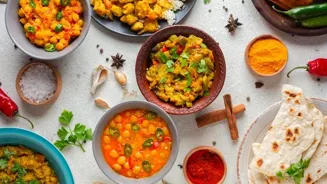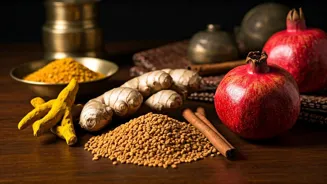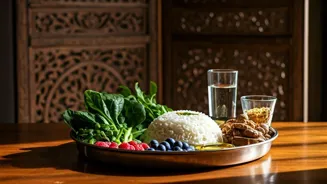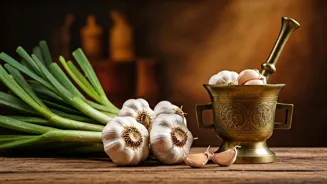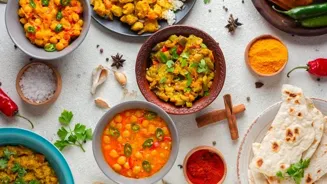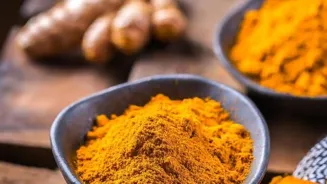Unlock Ayurveda's Secrets in Indian Cooking: A Journey of Wellness Through Ingredients. Delve into the ancient wisdom that shapes modern kitchens
In the bustling kitchens of India, where aromas of spices
dance and generations share culinary secrets, lies a profound connection between food and well-being.
This ancient link is deeply rooted in Ayurveda, the traditional Indian system of medicine that views food not just as sustenance but as a powerful tool for maintaining health and harmony.
Ayeurveda, with its holistic approach, considers the individual's unique constitution, known as doshas, and recommends dietary choices that balance these energies.
This philosophy has significantly shaped Indian cooking, influencing the selection of ingredients, cooking methods, and even the timing of meals.
Let's delve into this fascinating relationship and explore how Ayurveda continues to nourish both body and soul through the art of Indian culinary traditions. It's fantastic how ancient knowledge still shapes our modern lives, especially in our kitchens.
The core of Ayurvedic cooking lies in understanding the three doshas
Vata, Pitta, and Kapha. Each individual possesses a unique combination of these doshas, and imbalances can lead to various health issues. Ayurvedic principles emphasize that food can either pacify or aggravate these doshas.
For instance, Vata individuals, often characterized by dryness and lightness, benefit from warm, grounding foods like cooked grains, root vegetables, and healthy fats. Pitta individuals, known for their fiery nature, thrive on cooling and hydrating foods such as cucumbers, melons, and leafy greens.
Kapha individuals, typically grounded and stable, need light, stimulating foods like spices, lentils, and vegetables. By consciously selecting ingredients and cooking techniques that align with their dominant dosha, individuals can promote balance.
It's really a personalized approach to eating that focuses on individual needs. Such knowledge is a treasure, offering better lifestyle with careful food selection.
Spices in Indian cuisine: Flavor enhancers and potent medicine
Spices hold a paramount position in both Ayurveda and Indian cooking. They are not merely flavor enhancers but potent medicinal agents with a wide array of health benefits.
Turmeric, with its anti-inflammatory and antioxidant properties, is a staple in Indian curries and is hailed as a "golden spice" for its remarkable healing capabilities.
Ginger, known for its warming and digestive qualities, is frequently used in teas and savory dishes to aid digestion and alleviate cold symptoms. Cumin, coriander, and fennel, often combined in spice blends, promote digestion, reduce bloating, and support overall gut health.
The strategic use of spices in Indian cooking not only elevates the taste but also transforms each meal into a therapeutic experience. It seems wise to view spices from two perspectives, for taste and for medicinal benefits. Indeed, this dual function exemplifies the Ayurvedic approach.
Ghee and legumes in Ayurvedic cooking promote well-being
Specific ingredients like ghee (clarified butter) and certain legumes also play a significant role. Ghee, considered a "rasayana" or rejuvenating substance in Ayurveda, is believed to enhance digestion, nourish tissues, and promote mental clarity.
Its rich, buttery flavor adds depth to dishes, while its therapeutic properties contribute to overall well-being. Certain legumes, carefully prepared to reduce their gas-producing effects, are valued for their protein and fiber content.
Moong dal, a light and easily digestible lentil, is often recommended for its gentle yet nourishing properties. It shows how preparation methods enhance beneficial effects of foods. This careful selection of ingredients has created delicious, yet healthy meals.
Ayurveda emphasizes mindful eating for better digestion and connection with food
Ayurveda extends its influence beyond just ingredients and considers the optimal timing and manner of eating. Eating meals at consistent times each day, particularly during daylight hours when digestive fire (agni) is strongest, is encouraged.
Mindful eating, paying attention to the taste, aroma, and texture of food, is also emphasized to promote better digestion and satiety. Avoiding distractions like television or mobile phones during meals and chewing food thoroughly are considered important practices.
These simple yet profound guidelines enhance the overall dining experience and promote a deeper connection with food. Such mindful practices turn meals into a way to connect with ourselves.
Resurgence of Ayurveda in modern life for holistic health
Today, amidst the pressures of modern life, there's a growing resurgence of interest in Ayurveda and its culinary wisdom. People are increasingly seeking natural and holistic approaches to health, and Ayurvedic cooking provides a framework for nourishing the body from the inside out.
From incorporating spices strategically into daily meals to choosing ingredients that balance individual doshas, the principles of Ayurveda are readily adaptable to modern lifestyles.
By embracing these ancient teachings, we can unlock the power of food to promote well-being and cultivate a more harmonious relationship with our bodies, truly nourishing our bodies with mother nature's gifts. It is fantastic seeing people revert back to ancient healing methods.
